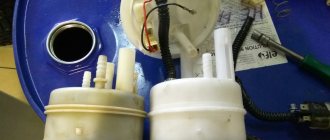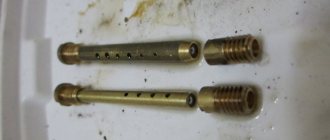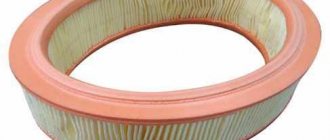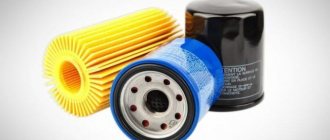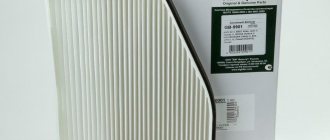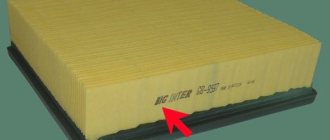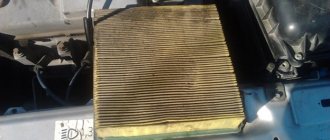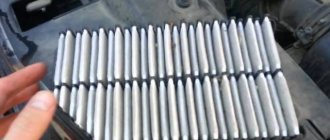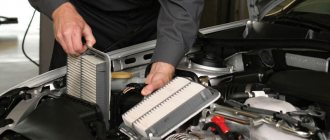The VAZ 2114 air filter is a key component of the internal combustion engine protection system. The filter does not allow dust, debris, or other foreign bodies to enter the working chambers of the motor; helps maintain its functional state.
The air filter is a consumable item: during operation it becomes clogged, is exposed to various influences and over time there is a need to replace it. The declared resource of the “air vent” is 30,000 km, but operational practice shows that in reality the filter is changed every 15-20 thousand mileage.
The “2114” model is equipped with panel-type air filters. In the era of carburetor engines, large round filters were installed on cars. The panel design made it possible to optimize the dimensions of the part and improve the performance properties of the filter element.
The mechanism of action of the VAZ 2114 air filter
The principle of operation of the filter element on the “fourteenth” can be described using the following algorithm:
- The outside air enters the air filter through the cooling system fan;
- At the outlet of the air filter, a mass air flow sensor is installed that monitors the amount of air intake by the engine. The engine operating mode depends on the sensor readings. If everything is OK, then the engine runs evenly, does not stall, and the declared fuel consumption regime is observed;
- Then the filtered atmospheric air enters the injector receiver; the air then participates in maintaining the operating pressure of the fuel system.
Procedure for replacing the filter on VAZ 2110, 2111 and 2112
Before replacing the filter, you need to pay attention to the associated electronics and electrical wiring. To avoid problems with this, you should de-energize the battery by disconnecting one of the terminals from it. Then, even if water gets on the wiring or a bare wire is accidentally touched by your hand, there will be no problems.
Changing this important system for a car - whether on an injection engine or a carburetor - is a very quick job, it only takes 5-10 minutes.
Tool preparation:
- Ten wrench;
- Curly screwdriver;
- Directly filter;
- Rags or rags.
Why you need to change your air filter promptly
If the air filter cannot catch dust, then grains of sand will begin to seep into the working chambers of the engine and melt in them. Melting products will settle on the engine parts and reduce their service life.
Signs of a clogged air filter:
- significant loss of car power: it is more difficult for air to penetrate into the working chambers of the internal combustion engine;
- Gasoline consumption increases. In real terms, with a clogged filter, consumption increases by an average of three liters;
- difficulty starting the engine even in warm weather;
- the engine pulls poorly and is not able to develop high speeds;
- fuel detonation increases.
Driving with an outdated air filter results in a sharp increase in spark plug wear; Additionally, malfunctions in the operation of the electronic engine control unit will occur. Often, a clogged air vent is the reason for the Check Engine light to turn on.
It is also necessary to change the filter element in a timely manner because it purifies the air entering the cabin from the environment.
Why change
But really, why? If you buy a filter, let it sit until the end of the car's service life. But no, you can’t do this under any circumstances, otherwise the car will really last very little.
Clogged air filter
There are several reasons why the air purifier should be replaced on a VAZ 2110.
- Pollution. As you use it, the element becomes dirty. The formation of contaminants leads to increased fuel consumption and difficulty starting the engine.
- Lack of proper air draft in the cabin, which makes it very stuffy inside. In parallel with this, the engine may operate unstably and floating speeds may appear. All this suggests that it is time for a replacement.
- Comprehensive service. When buying a car second-hand or during scheduled maintenance, the new owner, as a rule, immediately changes all consumables, fills in new oil, and installs new filters.
Buying a new part
A new filter for the “fourteenth” costs no more than 300 rubles. Spare parts are sold in any stores specializing in the domestic automobile industry. It should be noted that the air filter housing for the VAZ 2114 is a separate part and must be purchased additionally. Low prices for components make installing a VAZ 2114 air filter a feasible task for any owner of a “chepyrka”.
Some craftsmen manage to clean used filter elements with their own hands, but in essence, the result is zero. The service life of remanufactured filters is extremely short, and manual cleaning requires a lot of time, so initially this idea is impractical.
Most car enthusiasts prefer a standard part marked VF-14. Sold at any car market for 150-200 rubles. If you are interested in the maximum service life of the filter element, we recommend purchasing components from German manufacturers (products from MANN and HENGST are available on the market).
So-called “zero resistance filters” are also commercially available. “Nuleviki” significantly increase engine power, but their installation requires additional modifications to the power unit.
Injection engine
- This type of engine has a round filter. Changing the filter element must begin by removing the cover from the main body. To do this, you need to unscrew all four fastening screws. It won't be possible to completely remove the cover and put it away so it doesn't interfere because of the interfering pipe, so you can just put it next to the engine. Just make sure that it is not hot, otherwise the plastic case will melt.
- Next, the old filter that has become unusable is carefully removed and a new one is put in its place. Just first you need to take a rag and clean the case from the dust that has accumulated there. Otherwise, all this dirt will immediately begin to clog the newly installed new cleaning element. When installing, you need to pay special attention to the corrugation of the new part. The location must correspond to the arrows marked on the inside of the filter and be located along them.
- Then the cover is put back and tightened with the same bolts. It is advisable to install it hermetically so that no dirt or dust gets inside. You can select and use a good rubber seal.
Replacement frequency, what oil to fill
According to the manufacturer's regulations, service changes of engine oil on the VAZ 2105 are carried out after 8,000-10,000 kilometers or at intervals of 1 year. But some car owners consider this interval to be a little too high, recommending that it be shortened taking into account operating conditions.
It is recommended to use semi-synthetic with a viscosity of 10W-40 as a lubricant. The following motor oils are most popular among model owners:
- Lada Professional 10W-40
- Lukoil Genesis Advanced 10W-40
- Shell Helix HX7 10W-40
- Total Quartz 7000 10W-40
From this list, anyone can choose based on preference, price or love for the brand.
When using this car in winter, you should select oil taking into account the climate zone, as well as the recommendations of AvtoVAZ. Viscosity 5W-40 will allow you to operate the car down to -30°C, and 0W-40 up to -35°C.
If you use motor oil of different viscosities for winter and summer, but of the same brand and manufacturer, then flushing is unnecessary.
Carburetor engine
The technology for changing the filter on a carburetor engine is the same. Only the lid is removed in a slightly different way.
- Using a wrench, you need to unscrew the nut in the middle of the lid and unfasten the 4 fastening latches on the sides.
- Next, the cover is also removed (there is no pipe, so you can safely put it on the ground), the old filter is removed, the housing is cleaned of dirt, and a new part is installed.
- The cover is placed back on the body and secured with a nut and side fasteners. Be sure to check whether the lid fits tightly to the body. If the fit is not tight, gaps will appear. Through which untreated dirty air will enter the engine.
Signs
How to determine that the cleaning element has become unusable? This can be done visually by opening the lid. If the filter is dirty in the same way as in the photo below, it can no longer be used.
Along with this, the driver will feel third-party signs indicating an upcoming replacement. If the filter is clogged, it will have difficulty passing air through it.
Accordingly, more fuel than oxygen will enter the cylinders. In reality, this means increased gas consumption. Usually it exceeds the norm by 5-7 percent. But that's not all. Due to the supply of a different fuel mixture and lack of oxygen, the car will literally “suffocate”. The driver will feel a drop in acceleration and power. It also becomes more difficult to start the engine in winter.
Modifications
- VAZ-2105 - 1.3 l. carb. VAZ-2105 engine with 4-speed Checkpoint.
- VAZ-21050 - 1.3 l. carb. VAZ-2105 engine with 5-speed Checkpoint.
- VAZ-21051 - 1.2 l. VAZ-2101 carburetor engine with 4-speed gearbox.
- VAZ-21053 - 1.5 l. carb. engine VAZ-2103 or injection VAZ-2104 with 5-speed. Checkpoint.
- VAZ-21054 is a small-scale modification produced for the traffic police, the Ministry of Internal Affairs and the FSB with an additional gas tank and battery.
- VAZ-21055 - 1.5 l. diesel VAZ-341 produced by Barnaultransmash, small-scale modification for taxis.
- VAZ-21057 (Lada Riva) - an export version of the VAZ-21053 with right-hand drive, produced in 1992-1997 for the UK.
- VAZ-21058 is an export version of the VAZ-21050 with right-hand drive, produced in 1982-1994 for the UK.
- VAZ-21059 - 1.3 l. rotary engine VAZ-4132 with a power of 140 hp.
| 2105 | 21051 | 21053 | 21055 | 21059 | |
| Performances | Four-stroke, gasoline, carburetor, four-cylinder | diesel | rotary | ||
| Body type | sedan | ||||
| Number of doors | 4 | ||||
| Places | 5 | ||||
| trunk volume, dm 3 | 345 | ||||
| Overall dimensions, mm : | |||||
| length | 4130 | ||||
| width | 1620 | ||||
| height | 1446 | ||||
| own weight, kg | 995 | ||||
| payload, kg | 400 | ||||
| Wheelbase, mm | 2424 | ||||
| Front wheel track | 1365 | ||||
| Rear wheel track | 1321 | ||||
| Drive wheels | rear | ||||
| Ground clearance to floor pan | 182 | 182 | 182 | ||
| Clearance to rear axle beam | 170 | ||||
| Clearance to front suspension beam | 175 | ||||
| Engine | 2105 | 2101 | 2103 | 341- diesel | VAZ 4132 |
| working volume, cubic meter cm | 1290 | 1198 | 1452 | 1524 | 1308 |
| Max. power, kW (at rpm) | 46,8 (5600) | 43,2 (5600) | 37(4600) | 103 (6000) | |
| Max. power, l. With . | 63,6 | 58,7 | 71,1 | 50,3 | 140 |
| Max. torque, Nm (at rpm) | 92(3400) | 85 (3400) | 103,9(3400) | 92,0 (2500) | 186 (4500) |
| supply system | carburetor | carburetor | carburetor | ||
| KP | |||||
| Number of gear stages | 5 or 4 | 4 | 5 or 4 | 5 | 5 |
| Gearbox ratios: | |||||
| I | 3,67 | 3,67 | 3,67 | 3,636 | 3,636 |
| II | 2,1 | 2,1 | 2,1 | 1,95 | 1,95 |
| III | 1,36 | 1,36 | 1,36 | 1,357 | 1,357 |
| IV | 1 | 1 | 1 | 0,941 | 0,941 |
| V | 0,82 | 0,82 | 0,784 | 0,784 | |
| reverse | 3,53 | ||||
| Final drive ratio | 4,1 | 4,3 | 4.1 or 3.9 | 3,9 | 3,9 |
| Maximum speed, km/h | 145 | 142 | 150 | 125 | 180 |
| acceleration to 100 km/h, s | 18 | 20 | 17 | 23 | 9 |
| Fuel consumption, l/100km: | |||||
| fuel consumption at 90 km/h | 7,5 | 5,8 | 9,5 | ||
| fuel consumption at 120 km/h | 10,1 | 8,0 | 12,5 | ||
| fuel consumption in the urban cycle | 10 | 6,7 | |||
| Fuel tank capacity, l | 39 | ||||
| Front brakes | disk | ||||
| Rear brakes | drums | ||||
| Braking distance loaded from 80 km/h | 38 | ||||
| Parking brake drive | cable | ||||
| Clutch drive | hydraulic | ||||
| Front suspension | independent | ||||
| Rear suspension | five-rod | ||||
| Steering | worm - roller | ||||
| Smallest turning radius | 5,6 | ||||
| The weight of the towed trailer is storm. | 600 | ||||
| Towed trailer weight without brakes | 300 | ||||
| Max, roof rack weight | 50 | ||||
| Maximum lift without acceleration | 34 | 34 | |||
| Resource until the first cap. repair, km | 150 000 | ||||
| Cold start temperature, C | -25 | ||||
| Tires | 13″ | 13″ | 13″ | 165/70R13 175/70R13 | 13″ |
| Dashboard | 2105 | ||||
| Seats | 2105 | ||||
| Rear window defroster | + | + | + | + | + |
| Cooling fan | mechanical | mechanical | mechanical | ||
| Bumpers | aluminum | ||||
| Exterior mirrors | left | ||||
| Seat upholstery | is . leather | ||||
| Headlining | film | ||||
| Door trim | unified |
* – as you master it ** – installed on special equipment
Some important points after replacement
After changing the filter, the fan will produce streams of fresh air. The windows will stop fogging up and it will be easier and fresher to breathe in the cabin. The filter gets dirty very quickly, which affects the condition of the vehicle. This can also adversely affect the driver’s health if this element is not replaced in a timely manner. The car's traction may decrease, and malfunction messages may appear on the instrument panel. If the edges of the filter do not fit into the grooves of the cover, they must be carefully trimmed using a stationery knife.
Note. When installing a new filter element, you should pay attention to the fact that the filter bellows are located along the arrows marked inside the filter housing.
All steps to replace the air filter can be done in just 15-20 minutes with your own hands:
- If there is no time to replace filters, you can blow out the old ones, but this will require a powerful compressor to help remove contaminants. But it’s better to change this element on time, especially since it takes a little time. Several bolts are unscrewed, the protection casing is removed, the internal cavity is cleaned, a new filter is installed and the casing is closed.
- During reassembly, you must carefully ensure that the rubber seal fits well into place, otherwise dust particles may get into the power supply system (injector), which can lead to significant and expensive car repairs.
Note. To ensure a better seal between the housing cover and the rubber seal of the filter, the bolts should be tightened evenly; it is recommended to crosswise so that the cover does not warp.
If the car is mainly used in the city, then the filter will not have to be replaced so often, and in principle you can drive up to 20 thousand kilometers. However, such runs will not lead to anything good for the village. If something happens, the mass air flow sensor, which costs quite a lot, will be the first to suffer. Therefore, it is better to spend 100 rubles and buy a new filter and not worry, than to pay 1500-2000 rubles for a new sensor in the future.
